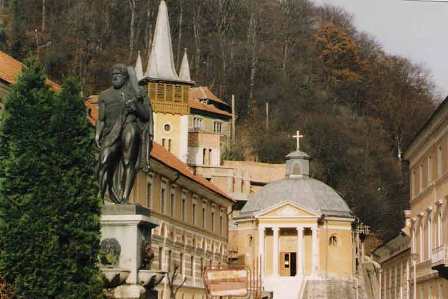Herkulesbad (German) – Herkulesfürdö (Hungarian) – Băile Herculane, Romania (Official)
Caras-Severin County – Western Romania
80km S of Karansebesch
Legend has it that the weary Hercules stopped in the valley to bathe and rest. During the 165 years of Roman domination of Dacia, the Herculaneum Spa was known all over the Empire. Unearthed stone carvings show that visiting Roman aristocrats turned the town into a Roman leisure center. Six statues of Hercules from the time have been discovered. A bronze replica of one of them, molded in 1874, stands as a landmark in the town center.
In modern times, the spa town has been visited for its natural healing properties: hot springs with sulfur, chlorine, sodium, calcium, magnesium and other minerals, as well as negatively ionized air. Before World War II, when the first modern hotel was built (i.e. H Cerna, 1930) it remained a popular destination with Western Europeans, who lent the town a refined elegance. During the Communist rule, mass tourism facilities were built, such as the 8-12 levels tall concrete hotels Roman, Hercules A, Hercules B, Afrodita, Minerva, Diana, UGSR, etc. which dominate the skyline. It was visited by all publics, but especially popular with employees and retirees, who would spend their state-allotted vacation vouchers there, hoping to improve their health. Today, they share the town with a younger crowd, attracted by its beautiful mountain setting. An incredible array of new private-owned pensions and hotels appeared after 1989, along the Cerna/Tiena river banks, spread from the beautiful romantic train station to the end of the hydroelectrical dam. Although very beautiful also, some of the Austro-Hungarian era buildings are derelict for the time being, including many of the baths, because of post-communism property related issues.
Catholic Church Name: Maria Himmelfahrt, final parish of Mehadia*

© Heinz Vogel
Last updated: 06/18/2025
